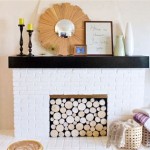Outdoor Stacked Stone Fireplace Ideas For Homes
An outdoor fireplace serves as a captivating focal point for any home's exterior living space, extending the usability of patios and decks well beyond the typical warm-weather months. Among the various materials used for constructing these outdoor features, stacked stone offers a unique blend of rustic charm, visual texture, and durability. The natural variations in color, size, and shape of the stones create a distinctive look that complements a wide range of architectural styles and landscaping designs. This article will explore various outdoor stacked stone fireplace ideas, offering insights into design considerations, material selection, and construction techniques to help homeowners create a personalized and inviting outdoor living area.
The allure of a stacked stone fireplace lies in its ability to evoke a sense of timelessness and connection to nature. It transforms an outdoor space into a cozy and inviting gathering spot for family and friends, perfect for relaxing evenings, outdoor dining, or simply enjoying the ambiance of a crackling fire. The selection of stacked stone, the overall design, and the surrounding landscaping all contribute to the fireplace's aesthetic impact and its integration with the home's overall style.
Design Considerations for Stacked Stone Fireplaces
Before embarking on the construction of an outdoor stacked stone fireplace, careful planning and design are essential. Several factors must be considered to ensure the fireplace is both aesthetically pleasing and functionally sound. These include the size and scale of the fireplace, its placement within the outdoor space, the style of stone used, and the overall architectural design of the home.
Size and Scale: The dimensions of the fireplace should be proportional to the size of the outdoor space. A massive fireplace in a small patio can overwhelm the area, while a small fireplace in a large backyard may appear insignificant. Consider the seating area around the fireplace and ensure there is ample space for comfortable movement. The height of the chimney should also be considered to ensure proper drafting and prevent smoke from blowing back into the seating area. Local building codes often dictate chimney height requirements.
Placement: The location of the fireplace significantly impacts its usability and visual appeal. Consider prevailing wind directions to minimize smoke issues. Position the fireplace in a location that offers some protection from the elements, such as under a covered patio or in a sheltered corner of the yard. Think about the views from the fireplace and ensure they are aesthetically pleasing. Avoid placing the fireplace in areas that are prone to flooding or have poor drainage.
Style of Stone: Stacked stone is available in a wide variety of colors, textures, and shapes. The choice of stone will significantly influence the overall look of the fireplace. Options include natural stone, such as fieldstone, river rock, or flagstone, as well as manufactured stone veneer. Natural stone offers a unique and rustic appearance, while manufactured stone veneer provides a more consistent and predictable look. Consider the existing architectural style of the home and choose a stone that complements it. For example, a home with a contemporary design might benefit from a sleek and linear stacked stone, while a home with a more traditional style might look best with a more rustic and textured stone.
Architectural Design: The fireplace design should seamlessly integrate with the overall architectural design of the home. Consider the roofline, siding materials, and window styles. The fireplace can either blend in with the existing architecture or serve as a contrasting focal point. Some popular design styles include traditional, modern, rustic, and Mediterranean. Each style has its own distinct characteristics and requires careful consideration of the materials and details used.
Material Selection for Stacked Stone Fireplaces
The selection of materials for an outdoor stacked stone fireplace is critical for both its appearance and its longevity. Choosing high-quality materials ensures that the fireplace will withstand the elements and provide years of enjoyment. Key materials include the stone itself, the mortar, the firebox, and the chimney.
Stone Selection: As previously mentioned, homeowners can choose between natural stone and manufactured stone veneer. Natural stone is generally more expensive but offers a unique and authentic look. Manufactured stone veneer is more affordable and provides a consistent appearance. When selecting natural stone, consider the color, texture, size, and shape of the stones. Choose stones that are durable and resistant to weathering. For manufactured stone veneer, ensure that the product is specifically designed for outdoor use and has been tested for freeze-thaw cycles. Consider the cut and style of the stone. Options include dry stack, where the stones are fitted tightly together with minimal mortar, and mortared stack, where mortar is visible between the stones.
Mortar Selection: The mortar used to hold the stones together is another critical component of the fireplace. Use a high-quality mortar specifically designed for outdoor use. Look for a mortar that is resistant to cracking and weathering. The color of the mortar can also affect the overall appearance of the fireplace. A darker mortar will accentuate the stones, while a lighter mortar will create a more subtle look. Consider using a pre-mixed mortar to ensure consistency and ease of application. Always follow the manufacturer's instructions for mixing and applying the mortar.
Firebox Selection: The firebox is the heart of the fireplace and must be durable and heat-resistant. Pre-fabricated fireboxes are a popular choice as they are easy to install and offer consistent performance. Choose a firebox that is appropriately sized for the fireplace and meets all local building codes. The firebox should be constructed of heavy-gauge steel or cast iron. Consider adding a grate to the firebox to allow for better airflow and easier cleaning.
Chimney Selection: The chimney is responsible for venting smoke and gases away from the fireplace. The chimney should be constructed of durable materials that can withstand high temperatures and the elements. Options include masonry chimneys constructed of brick or stone, and metal chimney systems. Metal chimney systems are generally easier to install and are available in a variety of styles and finishes. Ensure that the chimney is properly insulated to prevent heat loss and condensation. The height of the chimney must meet local building codes to ensure proper drafting. Consider adding a chimney cap to prevent rain and debris from entering the chimney.
Construction Techniques for Stacked Stone Fireplaces
Proper construction techniques are essential for ensuring the stability, safety, and longevity of an outdoor stacked stone fireplace. Hiring a qualified contractor with experience in masonry and fireplace construction is highly recommended. However, understanding the basic construction principles can help homeowners make informed decisions and communicate effectively with their contractor.
Foundation: A solid foundation is crucial for supporting the weight of the fireplace. The foundation should be constructed of concrete and should extend below the frost line to prevent cracking and shifting due to freezing and thawing. The foundation should be level and properly compacted. Consider adding reinforcing steel to the foundation for added strength. Ensure that the foundation is properly drained to prevent water damage.
Firebox Installation: The firebox should be installed according to the manufacturer's instructions. Ensure that the firebox is level and securely attached to the foundation. The firebox should be properly insulated to protect the surrounding materials from heat. Consider adding a firebrick lining to the firebox for added protection and heat retention. The firebox should be positioned so that it is accessible for cleaning and maintenance.
Stone Placement: The placement of the stacked stone is a critical step in the construction process. Begin by selecting the largest and most visually appealing stones for the base of the fireplace. Place the stones carefully, ensuring that they are level and securely mortared in place. Use a level to check each stone as it is placed. Stagger the joints between the stones to create a more visually appealing and structurally sound surface. Use a chisel and hammer to shape the stones as needed. Fill the gaps between the stones with mortar, ensuring that the mortar is evenly distributed. Allow the mortar to cure completely before adding the next layer of stones.
Chimney Construction: The chimney should be constructed according to local building codes. Ensure that the chimney is properly supported and securely attached to the firebox. Use a high-quality mortar to hold the chimney stones or bricks together. Consider adding a flue liner to the chimney to protect the masonry from corrosion. The chimney should be properly insulated to prevent heat loss and condensation. Install a chimney cap to prevent rain and debris from entering the chimney. Inspect the chimney regularly for cracks or damage.
Finishing Touches: Once the fireplace is complete, add finishing touches to enhance its appearance and functionality. Consider adding a hearth made of stone, brick, or concrete. The hearth provides a safe and comfortable place to sit or stand near the fire. Add a mantel to the fireplace to provide a decorative shelf. The mantel can be made of wood, stone, or metal. Install lighting around the fireplace to create a warm and inviting ambiance. Landscape around the fireplace with plants, shrubs, and trees to create a natural and harmonious setting. Add comfortable seating and outdoor furniture to complete the outdoor living space.
By carefully considering these design considerations, material selection, and construction techniques, homeowners can create a stunning and functional outdoor stacked stone fireplace that will enhance their home's value and provide years of enjoyment.

30 Outdoor Fireplace Ideas For A Cozy Backyard

Outdoor Fireplace Ideas Design For Fireplaces

Outdoor Stone Fireplace Ideas With Stacked Genstone

17 Modern Stacked Stone Fireplace Ideas For Your Home

30 Outdoor Fireplace Ideas For A Cozy Backyard

Outdoor Fireplace Ideas Inspiration Dutchies Stoneworks

17 Modern Stacked Stone Fireplace Ideas For Your Home

Transform Your Backyard With An Outdoor Stone Fireplace

Outdoor Fireplace Ideas Inspiration Dutchies Stoneworks

12 Stacked Stone Fireplace Ideas For Optimal Coziness Angi
Related Posts








